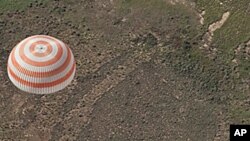Three crew members of the International Space Station are back on Earth after spending most of the past six months living aboard the orbiting laboratory. Hours after landing, they discussed their impressions about returning to their home planet, and, for one astronaut, what it was like to revisit the space station after five years away.
Expedition 23 Commander Oleg Kotov, NASA Flight Engineer T.J. Creamer and Japan Aerospace Exploration Agency Flight Engineer Soichi Noguchi smiled, waved and gave thumbs-up signs after they were removed from their spacecraft that landed on the steppes of Kazakhstan Wednesday morning, local time.
If you add up the number of days, the three men have spent a cumulative 700 days in space in their lifetimes.
Speaking to reporters within hours of landing, Noguchi compared his latest visit to the space station to his trip there in 2005. It was almost as if he were returning to a city he had visited years before, and he definitely noticed the changes.
"The last time I visited was five years ago and since then it almost like double or triple the size," said Soichi Noguchi. "And the station was very beautiful, very well organized thanks to the folks on the ground. It is just fun to live there and do experiments and work with all the ground folks."
The International Space Station is a work-in-progress, but after 22 years, it is nearly complete. Engineer Creamer says he saw enhancements during his 163 days up there, including the addition of a seven-windowed module called a cupola.
"We had a lot of logistics all in this five and a half months, but probably to top it all off would be just opening the window to the cupola," said T.J. Creamer. "It is just a phenomenal view."
The cupola gives crew members a panoramic look at the Earth. Aside from the out-of-this-world view, Creamer says the space station has some of the same support structures that a terrestrial city might have.
"We do have the medical capabilities on board equivalent to a small emergency room, for instance," he said. "We don't go driving around this city, but we do indeed go transporting through that city. It is...spectacular is the best word I can give you right now."
The space station has been continuously occupied since 2000, when a U.S. and Russian crew first inhabited it. Creamer says the return home is bittersweet, in part because he will miss the people he bonded with on the station.
"The other side of course is coming home and going to a place where there is quiet actually," said Creamer. "When you were sitting out on the steps, you could hear nothing for a little bit, which was unusual for us. You could smell the fresh air. We were looking forward to this."
Sixteen countries have collaborated on the space station, including the United States, Canada, Japan, Russia and 11 participating member nations of the European Space Agency, as well as support from Brazil.
"It's definitely an international environment, and it shows, you know, inside the station," he said. "There's a lot of experiments from around the world."
Experiments include measuring the effects of apparent weightlessness on people and plant life, and producing protein crystals for medical research.
Astronauts Describe Life on International Space Station







